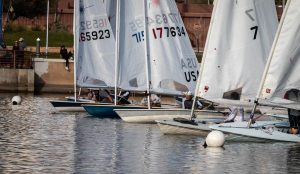

How to get faster in light air. This is a question that has been asked around sailing clubs since the beginning of time. I have listed below a couple of ways to help.
-
Use Other Boats To Help You Get Faster
One great method is to use a tuning partner to optimize a one-design sailboat’s performance in light air. It’s important though to choose a Compatible Partner who is of a similar skill level. Choosing a compatible tuning partner ensures that both of you can benefit equally from the sessions.
Take turns sailing close to each other at different points of sail (upwind, downwind, reaching). Observe and compare each boat’s speed, pointing ability, and overall handling characteristics. Take turns at being the weather or leeward boat.
Initially, set your boats up the same, then sail upwind together to ascertain relative speed. One boat then makes an adjustment and then you sail upwind again together for the same distance. Keep detailed notes of your changes and how they affect your boat’s performance.
Use your tuning partner as a benchmark to refine your sailing techniques and boat-handling skills.
Compare speeds and note which configurations perform best. Discuss findings to refine and improve understanding of subtle adjustments that affect speed and pointing ability.
Consider using a GPS device or smartphone app to record speed and course data during tuning sessions. This data can provide valuable insights into your boat’s performance concerning your tuning partner.
By working closely with a tuning partner, you can leverage each other’s strengths and experiences to optimize your one-design sailboat’s light-air performance.
-
Solo Light Air Improvement.
It is very difficult to improve your boatspeed very much by working alone and solo training to improve light-air sailing performance requires a focused approach.
Of course, there are some things you can do by yourself in areas such as boat preparation, sail shape and boat handling.
Practice manoeuvres such as tacks, gybes, and mark roundings in light air conditions. Focus on maintaining boat speed throughout the manoeuvre and minimizing loss of momentum.
Experiment with different crew weight placements to minimize drag and maximize boat balance. Practice moving smoothly to adjust weight distribution without disrupting the boat trim
Develop your ability to read wind shifts and identify pressure variations on the water. Practice sailing upwind and downwind angles to maximize efficiency in varying wind conditions.
Even though they may be illegal in your class, there are many awesome GPS-based instruments available. For training purposes, these can help you see the differences in speed that shifting weight or changes in sail shapes and rig tensions can achieve.
Consistent solo training with a structured approach will gradually enhance your skills and confidence in light air conditions. This leads to improved performance and competitiveness in races.
-
Using A Coach For Light Air Gains
A coach will start with a thorough assessment of your current sailing skills in light air conditions. They will observe your boat handling, sail trim, and tactical decisions in real-time.
Your coach will use video analysis and feedback to show you how to fine-tune sail trim and technique. Reviewing footage allows you to pinpoint areas of improvement in sail trim, boat handling, and tactical decision-making.
The coach will have spent thousands of hours watching sailors training and competing and they see things that most sailors would miss.
By leveraging the expertise of a sailing coach, you can accelerate your learning curve and develop the skills necessary to maximize speed and performance in light air conditions.
-
Conclusion
Attend clinics or seek feedback from experienced sailors and coaches. Use their insights to refine your techniques and strategies for improving light-air sailing performance.
There is a wealth of information on the Internet and in Books, Blogs, Newsletters and YouTube videos. Become a sponge of information, sailing is one of those sports in which you never stop learning and never know it all.

